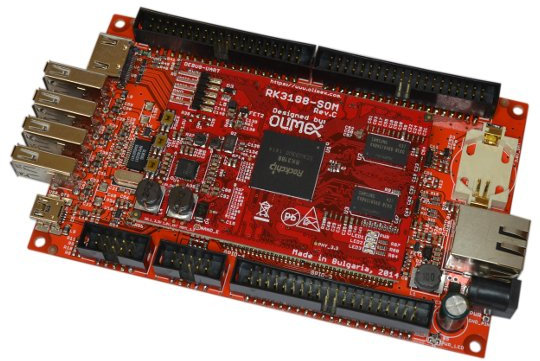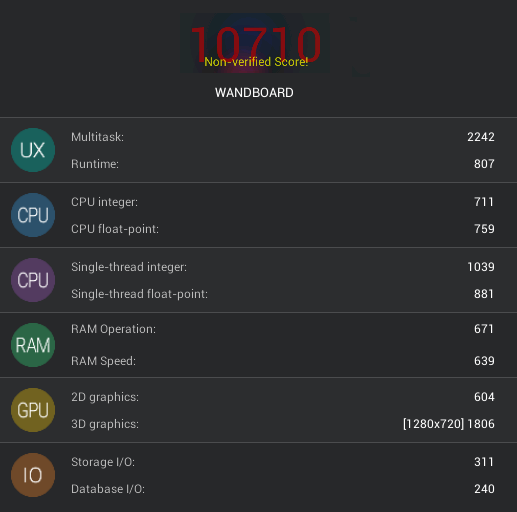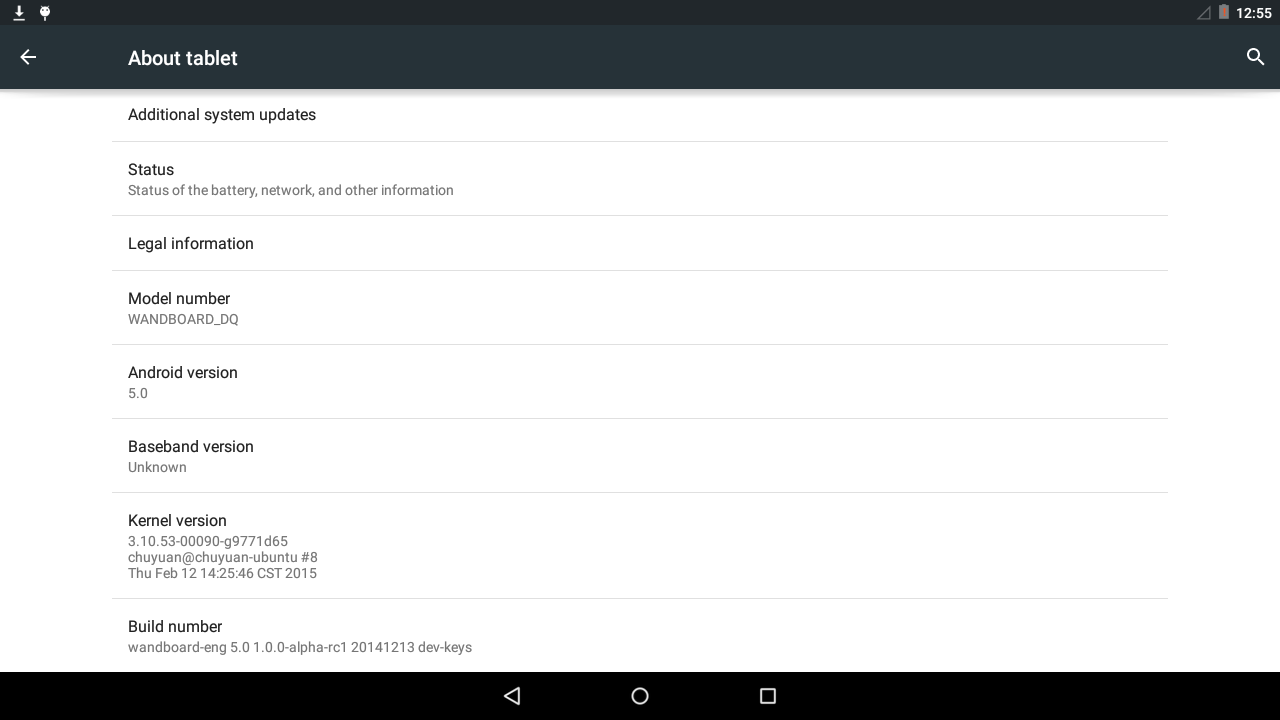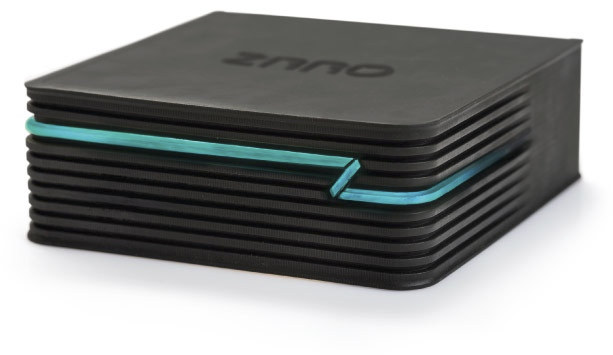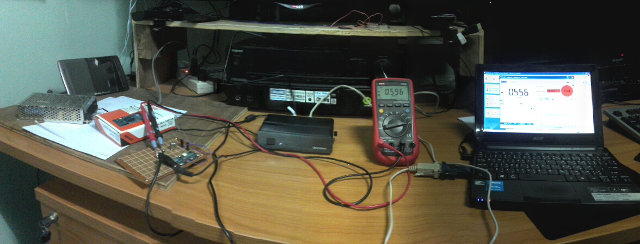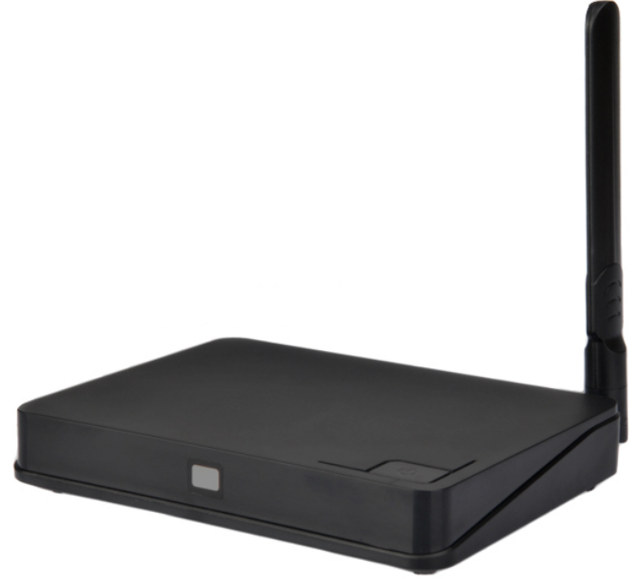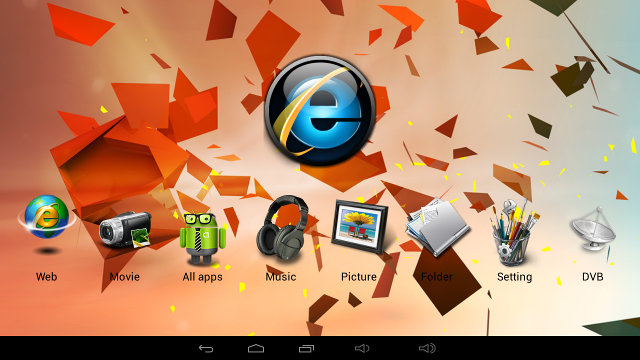When I first started to review Rockchip RK3288 based TV boxes I noticed several had critical issues with Ethernet including Nagrace HPH NT-V6 and Kingnovel K-R6. The main cons of the Nagrace media player included: XBMC has too many issues: VC1 not supported, H.265 support only partial, audio/video sync issue, some MPEG-2 and XVID videos are skipping frames, some of the 4K videos I used could play properly, etc… Some MPEG-2 file won’t play smooth in either XBMC or MX Player Potential Ethernet issues, confirmed with my Gigabit switch (D-Link DSG-1005A) and 10/100Mbps D-Link router (configured as a switch). Since then SPMC and Kodi must have improved video playback issues, but as late as last month I still got feedback from one person (Mr. B.) complaining about Ethernet on HPH NT-V6, but he finally got an email with a new firmware that is said to fix the Ethernet issues and […]
Olimex Announces Availability of TI AM3352 and Rockchip RK3188 SoM and Evaluation Boards
Olimex showcased prototypes for both Texas Instruments Sitara AM3352 and Rockchip RK3188 system-on-modules and evaluation boards in May 2014. However, development and production took a bit longer than expected, and the company has just announced availability of the platforms now. Rockchip RK3188 CPU Modules and Kit RK3188-SOM-EVB kit specifications: RK3188-SOM-4GB System-on-Module with the following key features: SoC – Rockchip RK3188 quad core Cortex A9 processor @ 1.6GHz with Mali-400MP4 GPU System Memory – 1GB DDR3 Storage – 4GB Flash + micro SD slot Debugging – 4-pin UART connector Misc – Reset and Recovery buttons, 3x status LEDs Dimensions – 55.88 x 81.28 mm Video Output – HDMI output + LCD output Connectivity – 10/100Mbps Ethernet USB – 4x USB Hosts, 1x micro USB OTG Expansion Connectors LCD connector for LCD-OLinuXino-XX LCDs 2x UEXT connectors 2x 40 pin GPIO connectors Misc – RTC with backup battery Power Supply – 6-16 V via […]
Android 4.1 vs Android 5.0 Performance Comparison
Most of the time people compare the performance of different hardware platforms, but since Wandboard released an Android 5.0 image in the last few days, I wondered what difference two years of software development may make by comparing benchmark results. So I ran both Antutu 5.6.1 and Vellamo 3.1 on Android 4.1.2 Jelly Bean (android-4.1.2-wand-dual-20130411.zip) and the latest Android 5.0 Lollipop firmware for Wandboard Dual (Freescale i.MX6 Dual) development board. Android 4.1.2 Benchmark Results Antutu 5.6.1 Vellamo 3.1 You’ll notice the yellow triangle on the top right corner of the multicore and browser results due to some warning related to missing CPU frequency information, and a DOM timeout. Android 5.0 Benchmark Results Antutu 5.6.1 The 2D graphics looked weird at some point as it zoomed out on1/4 of the display. The screenshot did not show the total score, so I added it manually to the picture above. Vellamo 3.1 Vellamo […]
Android 5.0 Lollipop Image for Wandboard Development Boards
Wandboard Solo, Dual and Quad are development boards powered by Freescale i.MX6 Solo, Dual, and Quad, that have been launched in 2013. I can remember running Android 4.1.2 and Ubuntu on both Wandboard Dual and Wandboard Quad. Fast forward to 2015, the board is still supported, and Android 5.0 Lollipop beta has been released for the three boards, making these one of the few hardware platforms supporting Android Jelly Bean, KitKat, and Lollipop. You can try it out by downloading the image, and flashing it to a micro SD card (8GB or more) as follows: Linux
|
1 2 3 |
wget http://www.wandboard.org/images/downloads/wandboard-lp-5.0.0-20150213-sdcard-boot.img.xz xz -d wandboard-lp-5.0.0-20150213-sdcard-boot.img.xz sudo dd if=wandboard-lp-5.0.0-20150213-sdcard-boot.img | pv | sudo dd of=/dev/sdX bs=16M |
Where X is the letter for your micro card which can be found with lsblk command Windows – Download wandboard-lp-5.0.0-20150213-sdcard-boot.img.xz, extract it, and flash to the the micro SD with Win32DiskImager. Insert the micro SD into the micro SD slot on the CPU board, and enjoy! At least in theory… If you have […]
ZRRO Android Game Console Includes a Hover and Touch Controller (Crowdfunding)
Android games are fun to play… on smartphones and tablets, but if you want to play such games on a TV screen via an Android mini PC, it can become more problematic, as most of the games were designed for touchscreen, so you have to be prepare to juggle between input devices.. In my reviews, I have to play Candy Crush Saga with an air mouse, and I switch to a wireless gamepad for racing games such as Riptide GP2 or Beach Buggy Racing, while some games are simply not playable at all without touch emulation, unless you install a software remote such as Droidmote on your smartphone, and use the latter as a controller, which may not be ideal either. ZRRO, an Israeli company, came with a new package comprised of an Android game console (ZRRO Box), and a game controller (ZRRO Pad) featuring a hover and touch surface […]
Power Consumption of Amlogic S812 and Rockchip RK3288 TV Boxes
The recent post comparing the power consumption of ODROID-C1 vs Raspberry Pi boards, as made me want to give another try at power consumption measurements. Regular reader already know I made a power measurement board and cables capable of hading different connectors (micro USB, mini USB, power barrels, etc..), but eventually it failed to deliver enough current to the boards for any meaning testing. But since I now have a better power supply, and multi-meter, it was worth another try, especially since I could draw some pretty charts. I decided to test the three most popular Chinese SoCs for mini PCs namely Amlogic S812 (4x Cortex A9), Rockchip RK3288 (4x Cortex A17), and Allwinner A80 (4x Cortex A15 + 4x Cortex A7) using respectively Eny M8S, Open Hour Chameleon, and A80 OptimusBoard. If you are paying attention, you must have noticed Allwinner A80 is not part of the title, that […]
M9 Android TV Box Based on Amlogic S812 Sells for $63 (Promo)
M9 (aka E8 Plus) is yet another Android media player powered by Amlogic S812 with 2GB RAM and 8GB flash, but it’s currently selling for $62.71 including shipping on Aliexpress from a seller with positive feedback. The offer is valid for 17 hours more. M9 specifications: SoC – Amlogic S812 quad core cortex A9r4 @ 2 GHz with octa-core Mali-450MP6 GPU @ 600+ MHz System Memory – 2 GB DDR3 Storage – 8GB NAND flash + SD card socket Connectivity – 10/100M Ethernet, dual band 802.11 b/g/n Wi-Fi, Bluetooth 4.0 Video Output – HDMI 1.4b up to 4K2K @ 30 Hz, AV port Audio Output – HDMI, AV, optical S/PDIF Video Codecs – 4k2k H.264, H.265 UHD, HD MPEG1/2/4, AVC/VC-1, RM/RMVB, Xvid/DivX3/4/5/6, RealVideo8/9/10, Audio Formats/Codecs – MP3, WMA, WAV, OGG, FLAC, APE, AC3, AAC etc… Dolby TrueHD & DTS-HD pass-through USB – 3x USB 2.0 host ports Misc – Power […]
HD18T Android DVB-T2 Receiver Mini Review
I’ve had HD18T Android TV box with a DVB-T2 tuner for several months, but I’ve only installed a roof antenna recently, so I’ve decided to give it another try since my indoor antenna did not pick-up any signal with that box. The set-top box is also known as EM6-T2 or HD18T2, and features Amlogic AML8726-MX dual Cortex A9 processor which has been used in numerous boxes in the past, so I will only focus on my experience with the DVB app in this mini review. If you want to use DVB-T2 go straight to the right and click on DVB app. Where you’ll then be greeted with a pop-up windowsasking if if you want to scan channels. You can do autoscan, manual scan (for one frequency), select the area (France/Taiwan/UK/Italy/Australia only), and enable/disable LCN (Logical Channel Numbering). At first I selected “Australia”, and the system did not find any channels, […]


